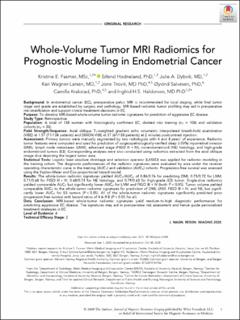| dc.description.abstract | Background
In endometrial cancer (EC), preoperative pelvic MRI is recommended for local staging, while final tumor stage and grade are established by surgery and pathology. MRI‐based radiomic tumor profiling may aid in preoperative risk‐stratification and support clinical treatment decisions in EC.
Purpose
To develop MRI‐based whole‐volume tumor radiomic signatures for prediction of aggressive EC disease.
Study Type
Retrospective.
Population
A total of 138 women with histologically confirmed EC, divided into training (nT = 108) and validation cohorts (nV = 30).
Field Strength/Sequence
Axial oblique T1‐weighted gradient echo volumetric interpolated breath‐hold examination (VIBE) at 1.5T (71/138 patients) and DIXON VIBE at 3T (67/138 patients) at 2 minutes postcontrast injection.
Assessment
Primary tumors were manually segmented by two radiologists with 4 and 8 years' of experience. Radiomic tumor features were computed and used for prediction of surgicopathologically‐verified deep (≥50%) myometrial invasion (DMI), lymph node metastases (LNM), advanced stage (FIGO III + IV), nonendometrioid (NE) histology, and high‐grade endometrioid tumors (E3). Corresponding analyses were also conducted using radiomics extracted from the axial oblique image slice depicting the largest tumor area.
Statistical Tests
Logistic least absolute shrinkage and selection operator (LASSO) was applied for radiomic modeling in the training cohort. The diagnostic performances of the radiomic signatures were evaluated by area under the receiver operating characteristic curve in the training (AUCT) and validation (AUCV) cohorts. Progression‐free survival was assessed using the Kaplan–Meier and Cox proportional hazard model.
Results
The whole‐tumor radiomic signatures yielded AUCT/AUCV of 0.84/0.76 for predicting DMI, 0.73/0.72 for LNM, 0.71/0.68 for FIGO III + IV, 0.68/0.74 for NE histology, and 0.79/0.63 for high‐grade (E3) tumor. Single‐slice radiomics yielded comparable AUCT but significantly lower AUCV for LNM and FIGO III + IV (both P < 0.05). Tumor volume yielded comparable AUCT to the whole‐tumor radiomic signatures for prediction of DMI, LNM, FIGO III + IV, and NE, but significantly lower AUCT for E3 tumors (P < 0.05). All of the whole‐tumor radiomic signatures significantly predicted poor progression‐free survival with hazard ratios of 4.6–9.8 (P < 0.05 for all). | en_US |

